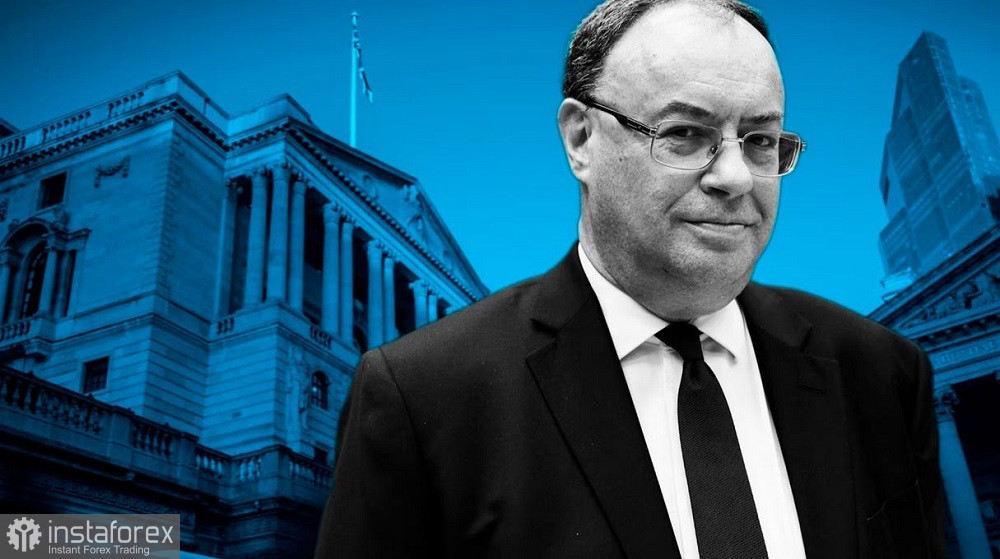The pound is plummeting across the market. In its pair with the dollar, the British currency has dropped by more than 150 pips in just a few hours. At the start of the European session on Thursday, the GBP/USD pair updated its local high at the 1.3269 mark, but by now, the price has approached the base of the 31st figure. Notably, the pair is plunging not only (and not primarily) due to the strengthening of the greenback but also the weakening of the pound. Look at the major cross pairs involving the British currency— the pound is losing ground rapidly even in pairs with the yen and the euro, both of which have been under pressure recently.
The reason for this is the Governor of the Bank of England, Andrew Bailey. In an interview with The Guardian, he announced a rate cut at the next meeting. According to him, the BoE will likely resort to more aggressive monetary easing "if inflation continues to show signs of slowing." Additionally, Bailey highlighted the resilience of the national economy, stating that the UK has weathered the shocks of the past five years "much better than many of us feared." Following these comments, the pound fell by more than 1% against the euro and the dollar.

Bailey's rhetoric on Thursday has triggered significant volatility, mainly because the outcome of the September meeting was fairly cautious. The number of members voting for a rate cut dropped to just one. Commenting on the BoE's cautious stance, the governor said that the central bank would need "further evidence" for the next step in monetary policy easing. Specifically, there is evidence that inflationary pressure is weakening and the national economy is growing.
The latest inflation report reflected stagnation in overall inflation (which remains above the target level) and an acceleration in core inflation. The only downward trend was seen in the Retail Price Index (RPI), which employers use in wage discussions. It came in at 3.5% after rising to 3.6% the previous month. However, this indicator remains near multi-month highs.
As a result, Bailey's statements came as a cold shower for GBP/USD traders. Essentially, for the first time, the head of the BoE mentioned the possibility of aggressive policy easing despite the central bank declaring a moderate pace of easing at the September meeting. Some experts had previously believed the Bank would reduce the rate no more than once per quarter. Now, analysts will have to revise their forecasts, primarily if the September inflation report for the UK (due on October 16) reflects a slowdown in CPI. The next BoE meeting will occur on November 7, making this inflation report the last one before the November meeting. The importance of this release cannot be overstated—it will essentially be the deciding factor for the BoE's decision.
The probability of a 25-basis point rate cut by the BoE next month is estimated at 70%, and the likelihood of a similar rate cut at the December meeting is 40%. Amid growing dovish expectations, the pound has come under significant pressure.
The GBP/USD pair faced additional pressure from a study published on Thursday. It showed that the CPI inflation expected by British companies for the quarter ending in September decreased by another 0.1 percentage point. This survey is quite important for the BoE's leadership and could also play a role in determining monetary policy parameters.
Moreover, the downward trend in GBP/USD is also driven by the rise of the U.S. dollar index, which reached a three-week high on Thursday, hitting 101.70. The U.S. dollar is appreciating on the back of strong U.S. labor market reports (JOLTS and ADP) and the rising oil market, which is reacting to the escalation in the Middle East. This information backdrop has influenced market expectations regarding the Federal Reserve's future actions. According to the CME FedWatch tool, the probability of a 25-basis point rate cut has increased to 67%. Meanwhile, the likelihood of a 50-basis point rate cut is now estimated at 33%, compared to 50-55% just last week.
Therefore, considering the current fundamental picture for the GBP/USD pair, short positions are favored, with the first target at 1.3040.
From a technical perspective, the pair has impulsively broken through the support level at 1.3230 (the middle line of the Bollinger Bands indicator, coinciding with the Kijun-sen line on the daily chart) and has currently dropped to the base of the 31st figure, positioned between the middle and lower Bollinger Bands lines, below the Tenkan-sen and Kijun-sen lines but above the Kumo cloud. The nearest target for the downward movement is the 1.3040 level – the upper boundary of the Kumo cloud on the D1 time frame. The main target is 1.2940 (the lower boundary of this cloud).
 English
English 
 Русский
Русский Bahasa Indonesia
Bahasa Indonesia Bahasa Malay
Bahasa Malay ไทย
ไทย Español
Español Deutsch
Deutsch Български
Български Français
Français Tiếng Việt
Tiếng Việt 中文
中文 বাংলা
বাংলা हिन्दी
हिन्दी Čeština
Čeština Українська
Українська Română
Română

